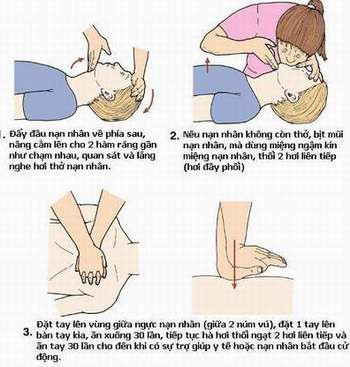3 things to note before jumping in to save a drowning person
(Baonghean.vn) - If you do not keep in mind the following 3 notes, the rescuer can also become a victim, even if you are a good swimmer.
In the event of a drowning person, everyone understands how urgent it is to save them. However, if you do not keep in mind the following 3 notes, the rescuer can also become a victim, even if you are a good swimmer.
To avoid unfortunate consequences, make sure you remember the following before deciding to jump in to save someone:
1. Identifying drowning people
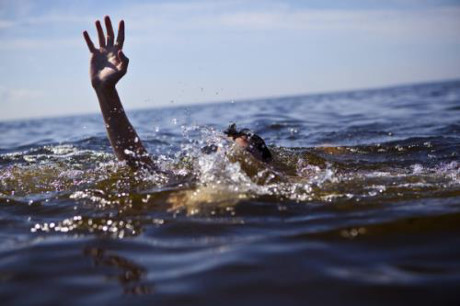 |
Normally, a drowning person begins to sink within 20-60 seconds, so the sooner you recognize it, the higher the chance of saving the person. Signs of a drowning person: First, their head is tilted back, but they continuously sink and float, while their body stays still in one place, not moving at all.
The mouth is constantly filled with water, or only slightly above the surface. The person may appear to be in great distress, but will not cry for help, possibly because there is not enough oxygen to do so.
2. Call for help, prioritize the use of rescue equipment
The first thing you should do when you know someone is drowning is to shout for help. Any help is valuable.
Next, look for support items around. At swimming pools or beaches, there will be rescue equipment scattered around such as buoys, tow ropes, etc. If the victim is still conscious and near the shore, attract their attention and throw out a piece of rope, or use a long tree branch for them to hold on to and pull up.
If the victim is far from shore, you can use a long rope. Roll the rope into a stiff loop and throw it towards the victim (remembering to hold one end). Ideally, aim to throw it over the victim and then bring the rope closer to them.
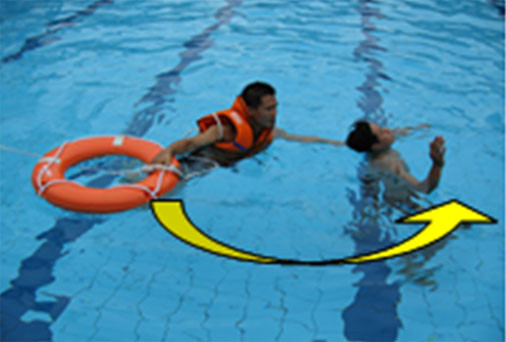 |
3. Jump down to save people
In case the victim is too far away, there is no object to reach, or you have thrown the rope and buoy many times but the victim cannot catch it, then that is the time you need to jump into the water. But of course you can not jump randomly, you must be prepared.
First, you must make sure that you can swim, and that you can swim well. A good swimmer may not save someone, but a poor swimmer or one who cannot swim will only increase the number of victims.
Next, absolutely avoid "jumping into the water with bare hands". Bring something that can float, it can be a ball, a tire... but not necessarily a buoy. Or you must bring a rope, with one end held by someone on the shore, or tied to a tree.
Once you have the support in your hand, swim towards the victim, instruct the victim to hold on to the object to float, then swim back to shore or signal someone on shore to pull them back. However, there is one thing that must be absolutely remembered: Approach the victim from behind.
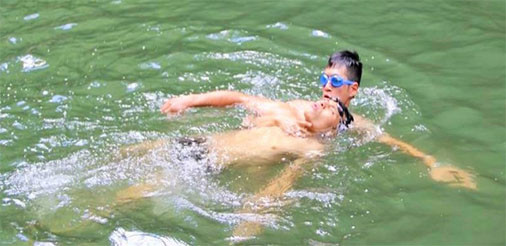 |
The drowning person is in a state of panic at that time, and they will do everything to float, including drowning the rescuer. In most cases, the rescuer becomes the next victim because of this phenomenon.
Especially if you don't have any support, you need to make sure you're approaching the victim in the right direction. Then, hug the victim from behind and pull them closer to shore.
If the victim is exhausted and completely submerged, approach the victim from below. Grab the victim's armpits, pull his head out of the water and start swimming towards shore.
First aid for drowning victims
After successfully bringing the victim to shore, you need to reassess the situation again.
If the victim is conscious, warm their body with dry cloths.
If the victim is unconscious and not breathing, immediately perform CPR. Meanwhile, bystanders should call an ambulance as soon as possible.
Only perform CPR on a victim whose heart is still beating (but this can cause serious injury). Do not perform artificial respiration if: The victim's heart stopped beating. You don't know how to do CPR. |
How to do artificial respiration
Let the victim lie in a well-ventilated place, loosen clothing and belt, and place a cushion under the neck with the head tilted back slightly to ensure the airway is clear.
Cover the victim's nose with one hand, pull the jaw down with the other hand to open the mouth, close the victim's mouth tightly and blow continuously two breaths for adults, one breath for children under 8 years old, then let the chest collapse and blow again. Adults and children over 8 years old must blow 20 times per minute. Children under 8 years old must blow 20 - 30 times per minute.
|
How to perform external cardiac massage
When the victim has cardiac arrest (putting your ear to the chest but cannot hear the heartbeat and feeling the pulse but cannot feel it), immediately perform first aid on the victim by performing external cardiac massage.
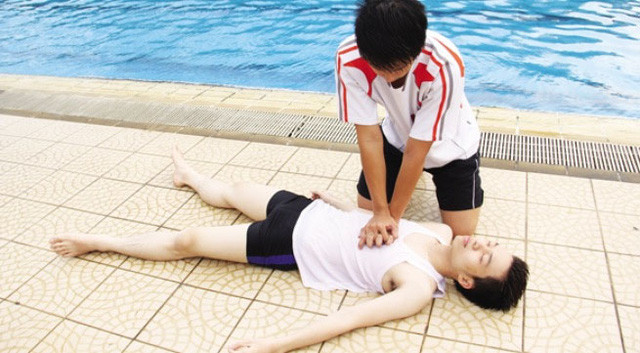 |
To have the victim lie on a hard flat surface, the person performing CPR kneels on the victim's left side. Place both hands on top of each other in front of the heart, corresponding to the point between the two nipples or the 4th - 5th intercostal space on the left side of the chest, slowly pressing down about 1/3 to half the thickness of the chest, then loosening the hands.
Adults and children over 1 year old, the number of chest compressions per minute is about 100 times. Children under 1 year old, the number of chest compressions per minute is more than 100 times. Newborns may need to have their chest compressed up to 120 times per minute.
When the victim has both cardiac and respiratory arrest: Must combine chest compressions with mouth-to-mouth resuscitation, for every 15 chest compressions, give two mouth-to-mouth resuscitations, for infants, three chest compressions and one mouth-to-mouth resuscitation.
Once the patient is breathing on their own, they should be taken immediately to the nearest medical facility for timely treatment.
Pear Flower
(Synthetic)
| RELATED NEWS |
|---|

